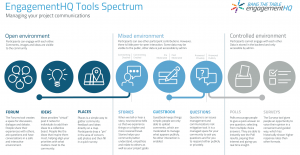
This guest post is by Michelle Stephens, AICP, Engagement Manager at Bang the Table
2020 continues to shine a bright light on local government, including  the processes and functions it does and doesn’t do well. As a planner and President of the Colorado Chapter of the American Planning Association, I’m particularly interested in how local government is adapting to fairly and efficiently processing development applications and facilitating community conversations around growth and land use.
the processes and functions it does and doesn’t do well. As a planner and President of the Colorado Chapter of the American Planning Association, I’m particularly interested in how local government is adapting to fairly and efficiently processing development applications and facilitating community conversations around growth and land use.
The COVID-19 pandemic is a game-changer. We are all feeling its effects profoundly. It has spurred digital transformations across all sectors. Work from home is the new normal for many (but not all). School districts, and the families they serve, are grappling with online vs. in-classroom formats. Communities are re-evaluating their funding priorities. They are creating space for conversations about race and the policies and regulations that have not served to support our democracy.
These changes have had a direct impact on our residents’ desire to be aware of and participate in the local government processes that have a direct impact on their day-to-day lives. In January, I posted a blog and hosted a webinar about development review and public notice. I outlined a case for a more inclusive process that was supported by technology to reach more members of your community — frequently and at a time and place that was convenient for them. Little did I know at the time that the need for easy-to-use digital community engagement tools would grow infinitely in less than two months.
I am no longer making the case for digital engagement. The then latent needs for online public engagement are now obvious to anyone who cares about democracy and their community. Instead, I offer examples below of how others are using online tools to improve their development review process.
Through the use of an online community engagement platform, these communities have created a one-stop-shop for their residents, and other interested stakeholders, to become aware, informed, and engaged in the development process from the comfort of their home and/or phone.
The result — local government transparency and trust from the community it serves.
- Golden, Colorado’s, development review webpage uses multiple online tools that provide the community with an opportunity to learn more about the development process and current development projects. I particularly like how they use engagement Level descriptions throughout the site to set expectations.
- Edina, Minnesota, is using their engagement website as the foundation for its online public hearings. They establish a dedicated project page for each project receiving a public hearing. The project pages provide a variety of information including project updates, staff contact info, key dates, and related project documents. They also include the opportunity for the public to leave comments and/or ask questions.
- Mercer Island, Washington, develops project-specific webpages on their engagement website for lager development proposals, while Missoula, Montana, provides information on all of their projects. Each project description includes a project name, brief description, links to application materials, comment deadline, and the name of the project planner assigned to the project review. Thus making it easier for the public to learn about and participate in the process.
Each of the sites above is dedicated to bringing more voices into the conversations that impact their communities. Their engagement sites provide a wide range of online tools that support all stages of public participation throughout the development review process — from initial concept through public hearings.
The flexibility and ease-of-use of their engagement sites ensure that the design and tools meet their community’s expectations and risk tolerance with minimal staff resources. In addition to saving valuable resources with communication, analysis, and reporting tools in one easy-to-use place, EngagementHQ makes it easy for the community to learn about and be involved with the projects that matter to them.
If you’re interested in:
- Improving your relationship with the public
- Hearing from more voices throughout the development review process
- Saving staff time
- Improving reporting
- Making community-informed decisions
Visit EHQ 4 Development Review. There you will find examples of how EngagementHQ can be used to Inform, Involve, and Consult, with your community.
To learn more about how online engagement tools and community participation enhance the development review process, register for the upcoming webinar on July 23rd, 2020 at 11am MST. We’ll outline 3 approaches to online engagement for the development review process and discuss the risks and benefits of each.
